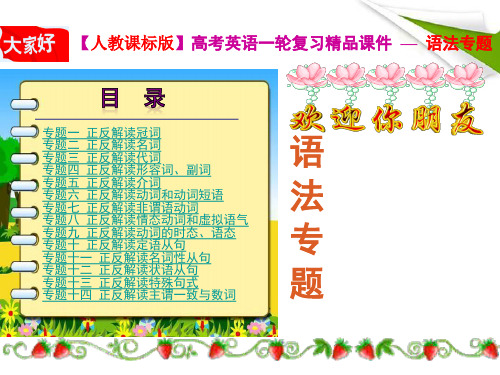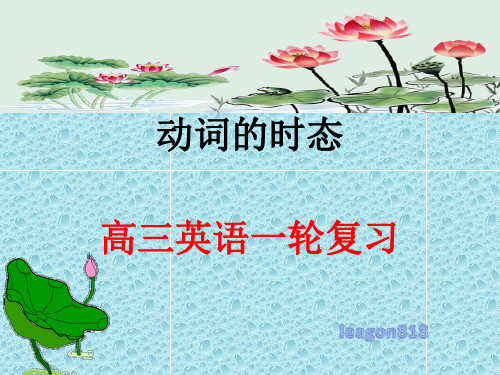高考英语一轮复习 精品语法课件 专题9 正反解读动词的时态、语态 新人教版
合集下载
高考英语一轮复习英语语法专题复习:时态和语态课件(共45张)

01 一般时态 Simple Tense
一般时态
past
一般过去时: did
now
一般现在时: do/does
future
一般将来时: shall/will do/be
一般现在时
一般现在时的用法: ① 目前的情况或状态
I am married.
② 经常性或习惯性的动作 I often cook meals for my family.
【高中语法】 时态与语态
语法知识
英语语法框架
音素★
语音 词法
音节 五种语音现象★ 九大词类 动词★ 词汇搭配 八种句子成分
时态 两大语态 三类非谓语动词
四类句子
句法
五种简单句
并列句
名词性从句
复合句★ 定语从句
特殊句式★ 状语从句
主谓一致
CONTENTS
时态与语态
• 一般时态 • 进行时态 • 完成时态 • 完成进行时态 • 主动语态 • 被动语态
模拟题解析
Look at the timetable. Hurry up! Flight 3753
15:30.
A. will take
B. takes
C. is taking
D. has taken
B off at
【解析】考查时态。飞机、火车等按时刻表运行,表达时用一般现 在时表示将来。
一般过去时
He didn't go shopping yesterday. ③一般疑问:Did+主语+动词原形+其他
Did he go shopping yesterday? ④特殊疑问句:疑问词+did+主语+动词原形+其他
2021届高考英语一轮复习-英语语法专题复习:时态和语态课件(共45张)

【解析】ቤተ መጻሕፍቲ ባይዱ查动词的语态。and前后连接相同格式的句子成分。后 半句的主语是代词they,谓语动词是give,根据句意应是“他们 被提供机会决定是否要参与研究”,故使用被动语态。
语态
• 主动语态改为被动语态的方法
Many people speak English. English is spoken by many people.
now
future
• 过去某个时间之前一直进行的动作 I had been looking for it for days before I found it. At that point, he realized what he had been doing all along.
完成进行时态
past
A. Has worked
B. worked
C. works
D. had worked
【解析】句意为“史密斯先生曾经在我们学校做了20年老师,他 现在是市长”。
一般过去时
一般过去时用法: ① 表肯定:主语+动词过去式+其他
He went shopping yesterday. ② 表否定:主语+did not (didn't)+动词原形+其他
真题解析
Potential subjects should be informed of the research and
D an opportunity to decide if they want to participate.
A. gave
B. giving
C. give
D. be given
now
future
【名师小堂】届高三英语人教版一轮复习语法时态语态PPT课件

18
4. Her mother was excited. “Your father has at last decided to stop swmasokininfogr,m”eJdane ____________ (inform).
后空是主语Jane的谓语,上文的谓语was 是一般过去时, 此外, 主语Jane与谓语 inform(告知)之间的关系是被动关系(被 告知), 同时主语Jane是单数。因此, 此题 答案应为:was informed。
9
6.过去完成时,表示在过去某一时刻或动作之 前已经完成了的动作,即“过去的过去”。 7.过去将来时,表示从过去某一时间来看将要 发生的动作或将要存在的状态。另外此处主语 dustbins为动作的承受者,所以用被动语态。 8.现在完成时,表示过去发生的某一动作对现 在造成的影响或结果。 9.一般将来时,表示在将来某一时刻要发生的 动作或存在的状态。
答案应为:results。
17
3. People stepped on your feeptuoshr e__d______ (push) you with their elbows, hurrying ahead to get to a bargain.
3. 主语people的谓语, 上文的并列谓语是 stepped, 可知时态, 语态与主谓一致。因此, 此 题的答案应为:pushed。
加入我们。会后,校长表示学校已经就改善校
园环境做出努力,并承诺将在校园设置更多的
垃圾箱。近期,学生会也制定了一些相关规章。
同时,大家必须做好自己并养成良好的习惯。
我们相信,在全体师生的共同努力下,我们的
校园环境一定会变得更好。
8
熟读深思
1.现在进行时,表示现在正在发生的动作。 2.现在完成进行时,表示过去就开始一直延续 到现在并有可能继续下去的动作。 3.一般现在时。经常性或习惯性动作。 4.一般过去时。在过去某个时间里(last week 上周)所发生的动作。 5.过去进行时,在过去某一时间正在进行的动 作。
4. Her mother was excited. “Your father has at last decided to stop swmasokininfogr,m”eJdane ____________ (inform).
后空是主语Jane的谓语,上文的谓语was 是一般过去时, 此外, 主语Jane与谓语 inform(告知)之间的关系是被动关系(被 告知), 同时主语Jane是单数。因此, 此题 答案应为:was informed。
9
6.过去完成时,表示在过去某一时刻或动作之 前已经完成了的动作,即“过去的过去”。 7.过去将来时,表示从过去某一时间来看将要 发生的动作或将要存在的状态。另外此处主语 dustbins为动作的承受者,所以用被动语态。 8.现在完成时,表示过去发生的某一动作对现 在造成的影响或结果。 9.一般将来时,表示在将来某一时刻要发生的 动作或存在的状态。
答案应为:results。
17
3. People stepped on your feeptuoshr e__d______ (push) you with their elbows, hurrying ahead to get to a bargain.
3. 主语people的谓语, 上文的并列谓语是 stepped, 可知时态, 语态与主谓一致。因此, 此 题的答案应为:pushed。
加入我们。会后,校长表示学校已经就改善校
园环境做出努力,并承诺将在校园设置更多的
垃圾箱。近期,学生会也制定了一些相关规章。
同时,大家必须做好自己并养成良好的习惯。
我们相信,在全体师生的共同努力下,我们的
校园环境一定会变得更好。
8
熟读深思
1.现在进行时,表示现在正在发生的动作。 2.现在完成进行时,表示过去就开始一直延续 到现在并有可能继续下去的动作。 3.一般现在时。经常性或习惯性动作。 4.一般过去时。在过去某个时间里(last week 上周)所发生的动作。 5.过去进行时,在过去某一时间正在进行的动 作。
高三英语一轮复习英语的时态和语态(共123张PPT)

过去完成 …before, by, until, when, after, once, as soon as
一般将来 next…, tomorrow, in…
过去将来
多用在间接引语中表示发生在谓语动作以后 的动作
15
导入之一:How is your daily life as a high school student?
9
9种时态的构成形式:都是靠动词本身的形式变化或借助助动词 实现。
动词原形和第三人称单数形式(do,does)都属于现在式,可 以表现在这种时间,过去式(did)表过去,但是动词没有将来 式,所以只能靠助动词will帮忙,will do表将来。
进行态用doing这种非谓语动词形式来表示,而完成态用done 这种非谓语动词形式表示。既然是非谓语动词,要想作谓语, 前面也要加助动词,doing前加be,done前have(has)。进 行态和完成态的时间变化只需要变助动词be和have。
2
1
他昨天来了. He came yesterday. 他已经来了. He has come. 他明天来. He will come tomorrow.
汉语借助词汇手段而非词的形态变化来表示 动作的发生,而英语主要通过谓语动词时态 变化来表现.任何句子都要先注意时态.
2
动词的分类
动词
谓语动词
非谓语动 词
13
16种时态=4种时间 X 4种状态 1句口诀总结:4时配4态,今过将来过将来,普进完成完成 进。(其中今就是现在,普是普通,也就是一般。)
14
最常用的几种时态与时间状语的搭配
一般现在 every …, sometimes, at …, on Sunday
高考英语一轮复习时态语态讲解课件

以辅音字母加y结尾的动词,先将y变i再加es
study→studies try→tries
以元音字母加y结尾的动词,在词尾加s
stay→stays play→plays
特殊:三单has 其他have, I用am三单is 其他are
一般现在时的标志词
• always 总是 often 经常 usually 通常 frequently经常 sometimes 有时
• on Sundays 在星期天
on Fridays 在周五
• every day/week/month/year 每天/ 周/月/年
• once/twice a week 每周一/两次 three times a week 一周三次
• every+基数词+可数名词复数 每隔…… every two years 每隔两年
• monthly每月 yearly 每年
必须使用一般现在时的情况1: 1. The sun rises from the east . 2. Shanghai lies in the east of China. 3. The earth is round . 4. Everybody loves panda. 5. Beijing never sleeps.
stop→stopped drop→dropped
prefer→preferred
不规则动词变化见不规则动词变化表
划出下列句子的被动语态。
1. Our classroom is cleaned by us every day.
被动语态的标志
2.English is widely spoken around the world. speak--spoke--spoken
高考英语一轮复习 精品语法课件 专题9 正反解读动词的时态、语态 新人教版

专题九 │ 正面解读
• 2. 一般过去时和现在完成时 • 一般过去时所表达的事件与现在无关。而现在完成时则强调 对现在的影响和结果。如: • I stayed in Beijing for five days. Then I went to America. (I am not in Beijing now. ) • I have stayed in Beijing for five days and haven't decided where to go next. (I am still in Beijing now and don't know where to go next.)
现 现 1.表示从过去某一时刻开始的动作一直延 时 完 要继续。 态 成 2.表示瞬间意义的动词不能用于现在完成 进 进行时。 行 时
在 在 续到现在,现在可能刚刚结束,也可能仍 all day.
专题九 │ 正面解读
• 类别 •
意义 例句 ①If the weather had been better, we could have had a picnic. But it rained all day. ②Sorry. I didn't know you were here.
一般过去时和过去完成时判断是不是过去完成时应先从时间轴上找到表示过去的时间点或动作然后判断在这个时间点或动作之前还有没有另一个动作并且判断该句是否强调发生在前
【人教课标版】高考英语一轮复习精品课件 — 语法专题 人教课标版】
专题一 正反解读冠词 专题二 正反解读名词 专题三 正反解读代词 专题四 正反解读形容词、副词 专题五 正反解读介词 专题六 正反解读动词和动词短语 专题七 正反解读非谓语动词 专题八 正反解读情态动词和虚拟语气 专题九 正反解读动词的时态、语态 专题十 正反解读定语从句 专题十一 正反解读名词性从句 专题十二 正反解读状语从句 专题十三 正反解读特殊句式 专题十四 正反解读主谓一致与数词
【高三英语】高三英语一轮复习动词时态课件ppt模版课件推荐精选PPT

The Smiths will live here for half a year. (表示他们现在还没有在这里居住) 如果需要表示瞬间动词的持续时间, 可以用 “It‘s 时间 + since…”的句子结构来表示. 如: It's 6 months since Tom came here. = Tom has been here for 6 months. 对于现在完成时不能望文生义,完成时在表示持续 动作时其实并未完成,动作尚未结束,还在持续之 中;而一般过去时的动作才是已经结束的动作。
3)表示最近发生的动作。常常与just, already, yet, still, recently等连用。
如: He has recently moved in here from New York. My car has just been repaired. Have you typed the letters already? She still haven't past her driving test.
注意:由于进行时表示的是正在发生的动作,因此, 表示状态、结果、情感、思维等的动词不可用于进 行时。这类动词有:
思维类:agree, appreciate, believe, consider(认为), disagree, disbelieve, expect, feel, figure(美:捉摸), find, get it(弄懂), guess, hear, hear about, hear of, hope, imagine, know(知道), realize, recognize, regard, see, see through, suppose, tell(辨 认), think(认为), understand, wonder, etc.
3)表示最近发生的动作。常常与just, already, yet, still, recently等连用。
如: He has recently moved in here from New York. My car has just been repaired. Have you typed the letters already? She still haven't past her driving test.
注意:由于进行时表示的是正在发生的动作,因此, 表示状态、结果、情感、思维等的动词不可用于进 行时。这类动词有:
思维类:agree, appreciate, believe, consider(认为), disagree, disbelieve, expect, feel, figure(美:捉摸), find, get it(弄懂), guess, hear, hear about, hear of, hope, imagine, know(知道), realize, recognize, regard, see, see through, suppose, tell(辨 认), think(认为), understand, wonder, etc.
高考英语一轮复习英语语法专题复习 态和语态优质课件ppt

01 一般时态 Simple Tense
一般时态
past
一般过去时: did
now
一般现在时: do/does
future
一般将来时: shall/will do/be
一般现在时
一般现在时的用法: ① 目前的情况或状态
I am married.
② 经常性或习惯性的动作 I often cook meals for my family.
【高中语法】 时态与语态
语法知识
英语语法框架
音素★
动词★ 词汇搭配 八种句子成分
时态 两大语态 三类非谓语动词
四类句子
句法
五种简单句
并列句
名词性从句
复合句★ 定语从句
特殊句式★ 状语从句
主谓一致
CONTENTS
时态与语态
• 一般时态 • 进行时态 • 完成时态 • 完成进行时态 • 主动语态 • 被动语态
一般过去时
一般过去时用法: ① 表肯定:主语+动词过去式+其他
He went shopping yesterday. ② 表否定:主语+did not (didn't)+动词原形+其他
He didn't go shopping yesterday. ③一般疑问:Did+主语+动词原形+其他
Did he go shopping yesterday? ④特殊疑问句:疑问词+did+主语+动词原形+其他
高考英语一轮复习英语语法专题复习 态和语态优质课件ppt
模拟题解析
Look at the timetable. Hurry up! Flight 3753
2021届人教版新课标高三英语一轮复习语法讲解 动词的时态36张PPT

• 3.[2019·全国卷Ⅲ语法填空]On the last day of our weeklong stay, we ________ (invite) to attend a private concert on a beautiful farm on the North Shore under the stars, listening to musicians and meeting interesting locals.
• 常与usually, always, often, sometimes, never, every day等表示频度的时间状语连用。
• On Monday morning it usually takes me an hour to drive to work.
• 星期一早晨,通常花费我一小时开车去上班。 • (2)表示客观真理、格言或者警句等 • 表示客观真理时,即使主句是一般过去时,宾语从
• 答案1.was driving2.am writing3.will be teaching
• (六)现在完成时
• 1.谓语动词的构成:have/has+done
• 2.基本用法
• (1)表示过去发生或已经完成的某一动作对现在造 成的影响或结果,常用的时间状语:already, so far, never, just, before, recently, for a long time, in the past/last/recent few years等。
• 2.[2019·全国卷Ⅱ语法填空]I love coming here and seeing my family and all the friends I ________ (make) over the years. I work not because I have to, but because I want to.
• 常与usually, always, often, sometimes, never, every day等表示频度的时间状语连用。
• On Monday morning it usually takes me an hour to drive to work.
• 星期一早晨,通常花费我一小时开车去上班。 • (2)表示客观真理、格言或者警句等 • 表示客观真理时,即使主句是一般过去时,宾语从
• 答案1.was driving2.am writing3.will be teaching
• (六)现在完成时
• 1.谓语动词的构成:have/has+done
• 2.基本用法
• (1)表示过去发生或已经完成的某一动作对现在造 成的影响或结果,常用的时间状语:already, so far, never, just, before, recently, for a long time, in the past/last/recent few years等。
• 2.[2019·全国卷Ⅱ语法填空]I love coming here and seeing my family and all the friends I ________ (make) over the years. I work not because I have to, but because I want to.
高考英语语法一轮复习——动词时态(共42张PPT)

4. be doing
“be + 动词的-ing形式”表示根据现在的计划或 安排,预期将会发生某事,这种安排不容随意改 变。
在这一结构中,动词-ing形式通常是表示位置转 移的动词,如 arrive, come, go, leave, move, start, stay, get 以及eat, meet, see off, die等,并与表示 将来的时间状语连用。
b. 表示指定要发生的事情
You are to be successful. His plan is to be a failure.
c. 表示命令或吩咐等。否定形式常表示“禁止” 或“不许”。
You are to be back before 10 p.m. You are not to go out alone at night.
3. was/were to do
She said she was to clean the classroom after school.
4. was/were doing
Nobody knew whether the guests were coming.
5. was/were about to do
Jane and Betty are going on holiday in a few days. Where are you staying in Guangzhou?
表示说话的瞬间就会发生的动作。
I felt something terrible was about to happen.
6. was/were on the point of doing
I'm glad you have come. I was on the point of calling you, but you've saved me the trouble now.
英语高考一轮复习名师解读专题:动词的时态和语态共66页PPT

英语高考一轮复习名师解读专题:动 词的时态和语态
1、战鼓一响,法律无声。——英国 2、任何法律的根本;不,不成文法本 身就是 讲道理 ……法 律,也 ----即 明示道 理。— —爱·科 克
3、法律是最保险的头盔。——爱·科 克 4、一个国家如果纲纪不正,其国风一 定颓败 。—— 塞内加 5、法律不能使人人平等,但是在法律 面前人 就越加自命不凡。——邓拓 12、越是无能的人,越喜欢挑剔别人的错儿。——爱尔兰 13、知人者智,自知者明。胜人者有力,自胜者强。——老子 14、意志坚强的人能把世界放在手中像泥块一样任意揉捏。——歌德 15、最具挑战性的挑战莫过于提升自我。——迈克尔·F·斯特利
1、战鼓一响,法律无声。——英国 2、任何法律的根本;不,不成文法本 身就是 讲道理 ……法 律,也 ----即 明示道 理。— —爱·科 克
3、法律是最保险的头盔。——爱·科 克 4、一个国家如果纲纪不正,其国风一 定颓败 。—— 塞内加 5、法律不能使人人平等,但是在法律 面前人 就越加自命不凡。——邓拓 12、越是无能的人,越喜欢挑剔别人的错儿。——爱尔兰 13、知人者智,自知者明。胜人者有力,自胜者强。——老子 14、意志坚强的人能把世界放在手中像泥块一样任意揉捏。——歌德 15、最具挑战性的挑战莫过于提升自我。——迈克尔·F·斯特利
届高考英语一轮复习学通语法课件 第 讲 动词的时态和语态 新人教版共61页文档

ENDΒιβλιοθήκη 届高考英语一轮复习学通语法课件 第 讲 动词的时态和语态 新人教版
61、辍学如磨刀之石,不见其损,日 有所亏 。 62、奇文共欣赞,疑义相与析。
63、暧暧远人村,依依墟里烟,狗吠 深巷中 ,鸡鸣 桑树颠 。 64、一生复能几,倏如流电惊。 65、少无适俗韵,性本爱丘山。
16、业余生活要有意义,不要越轨。——华盛顿 17、一个人即使已登上顶峰,也仍要自强不息。——罗素·贝克 18、最大的挑战和突破在于用人,而用人最大的突破在于信任人。——马云 19、自己活着,就是为了使别人过得更美好。——雷锋 20、要掌握书,莫被书掌握;要为生而读,莫为读而生。——布尔沃
- 1、下载文档前请自行甄别文档内容的完整性,平台不提供额外的编辑、内容补充、找答案等附加服务。
- 2、"仅部分预览"的文档,不可在线预览部分如存在完整性等问题,可反馈申请退款(可完整预览的文档不适用该条件!)。
- 3、如文档侵犯您的权益,请联系客服反馈,我们会尽快为您处理(人工客服工作时间:9:00-18:30)。
过 一 1.主要表示过去某时发生的情况或动作 去 般 (包括过去习惯性的动作)。2.所表达的事 时 过 件与现在无关。3.即使是刚刚发生的事情 态 去 也要用过去时。 时
专题九 │ 正面解读
• 类别 •
意义 例句 ①As she was reading the newspaper, Granny fell asleep.②My grandfather was always forgetting things. ③Mr.
专题九 │ 正面解读
• •
类别 意义 其特殊用法: 1.单纯的将来。 2.说话时临时的打算。 例句 ①I will be 17 next month. ②—Sorry, I forgot to post your letter. —It doesn't matter. I will go and post it myself.
专题九 │ 正面解读
• • • • • • • 如: [2010·重庆卷] The palace caught fire three times in the last century,and little of the original building ________ now. A.remains B.is remained C.is remaining D.has been remained 【解析】 A 考查动词用法及时态。remain作不及物动词用, 表示“剩下,仍有”,只能用于主动语态,不可直接跟宾语。结合 语境应用一般现在时表示现状。
语 法 专 题
•专题九 •正反解读动词的时态、语态
专题九 │ 考点荟萃 考点荟萃
动词的时态和语态一直是历年高考的必考点。主要考查 考生在特定语境下对时态和语态的理解,其中现在完成时、一般 过去时、过去完成时的运用出现得最为频繁。此外,为了增加试 题的区分度,命题者还常常把动词的时态和语态以及主谓一致结 合在一起考查。
• 类别 •
意义 例句 ①My brother is reading
现 现 1.表示说话时或现阶段正在进行的动作。
在 在 2.与副词always,continually, an interesting novel 时 进 constantly,never等连用时表示厌恶或赞 these days. 态 行 扬等的感情色彩。 时 3.go,come,leave,start,stay等少数 ②You are always forgetting the important
【人教课标版】高考英语一轮复习精品课件 — 语法专题 人教课标版】
专题一 正反解读冠词 专题二 正反解读名词 专题三 正反解读代词 专题四 正反解读形容词、副词 专题五 正反解读介词 专题六 正反解读动词和动词短语 专题七 正反解读非谓语动词 专题八 正反解读情态动词和虚拟语气 专题九 正反解读动词的时态、语态 专题十 正反解读定语从句 专题十一 正反解读名词性从句 专题十二 正反解读状语从句 专题十三 正反解读特殊句式 专题十四 正反解读主谓一致与数词
态 在 动作起止的动词有时也可用一般现在时代 new year. ②If it rains 时 替一般将来时,表示一个按规定、计划或 tomorrow, will you still go? 安排要发生的动作。 ③The plane for Canada leaves at 9:15.
专题九 │ 正面解读
将 will (shall) 来 +do 时 态
专题九 │ 正面解读
• •
类别 意义 例句 ①—Ann is in hospital. —Yes, I know. I'm going to visit her tomorrow. ②Look at the clouds. It is going to rain.
•
专题九 │ 正面解读
• 在解题时要注意以下几个问题: • 1. 这个动作可能发生在什么时间?题干中可参照的时间信息有哪 些? • 2. 这个动作处于什么状态?是进行中,还是已结束(完成)?限制 或修饰这个动作的状语信息有哪些? • 3. 这个动作与主语的关系,是主动还是被动? • 只要全面细致地考虑了这些问题,试题的答案也就水落石出了。 •
现 现 1.表示从过去某一时刻开始的动作一直延 时 完 要继续。 态 成 2.表示瞬间意义的动词不能用于现在完成 进 进行时。 行 时
在 在 续到现在,现在可能刚刚结束,也可能仍 all day.
专题九 │ 正面解读
• 类别 •
意义 例句 ①If the weather had been better, we could have had a picnic. But it rained all day. ②Sorry. I didn't know you were here.
专题九 │ 正面解读
意义 • 类别 •过 过 1.表示某一动作或存在的状态发生在过去 去 去 某一时间或动作之前,即“过去的过去”。 时 完 可以用by,before等介词短语或一个时间 态 成 状语从句来表示,也可以用一个表示过去 时 的动作来表示,还可能通过上下文来表示。 2.表示由过去的某一时刻开始,一直延续 到过去另一时间的动作或状态,常和for, since构成的时间状语连用。3.动词think, want,hope,mean,plan,intend等用过 去完成时来表示过去未曾实现的想法、希 望、打算或意图等。4.用在 hardly…when…,no sooner…than…,It was the first (second, etc.) time (that)…等 固定句型中。 例句 ①By nine o'clock last night, we had got 200 pictures from the spaceship. ②I had been at the bus stop for 20 minutes when a bus finally came. ③They had wanted to help but could not get there in time. ④Hardly had he begun to speak when the audience interrupted him.
专题九 │ 正面解读
• 类别 •
意义 例句 ①I've been sitting here ②Now that she is out of a job, Lucy has been considering going back to school, but she hasn't decided yet.
专题九 │ 正面解读
• 2. 一般过去时和现在完成时 • 一般过去时所表达的事件与现在无关。而现在完成时则强调 对现在的影响和结果。如: • I stayed in Beijing for five days. Then I went to America. (I am not in Beijing now. ) • I have stayed in Beijing for five days and haven't decided where to go next. (I am still in Beijing now and don't know where to go next.)
在 在 生于过去,对现在有一定的影响或结果。 classroom. (即: The 时 完 ②表示动作或状态过去已经开始,持续到 room is clean now. ) 态 成 现在而且可能继续下去。 时 2.短暂性动词在肯定句中不可与表示时间 段的for, since等连用。 3.可用在表时间、条件、让步的状语从句 中,表示将来某时以前已完成的动作。 4.在It is the first/ second … time that… 句型中,that从句的谓语动词用现在完成 时。 ②He has lived in this country for 40 years. ③Once you have made a promise, you shouldn't break it. ④It is the first time that I have been here.
专题九 │ 正面解读
• 二、几种易混时态的辨析 • 1. 一般现在时与现在进行时 • 一般现在时表示经常性的、习惯性的或状态性的行为。 而现 在进行时则具有进行性、未完成性和暂时性的特点。如: • On the wall hangs a picture painted by Qi Baishi. • This is not my coat. Mine is hanging behind the door. •
过 过 1.表示过去某一时间正进行的动作 。通 去 去 常有时间状语(从句),或有上下文提示。 时 进 2.与副词always, continually, constantly, 态 行 never等连用时表示厌恶或赞扬等的感情 时 色彩。3.go,come,leave,start,stay
等少数表示来、去、开始、离开等意义的 Smith said he was 瞬间动词的进行时可以表示一个按规定、 leaving for London soon. 计划或安排好的过去某个时间将要进行的 动作。
专题九 │ 正面解读 正面解读
• 一、动词时态的基本结构和用法 意义 •类别
现 一 1.主要表示现在的特征、状态、经常性动 在 般 作或客观事实等。2.用在时间状语从句和 时 现 条件状语从句中,表示将来。3.少数表示
例句 ①I play ping pong qud time to play since the
专题九 │ 正面解读
• •
类别 意义 例句
将 be 来 about to 时 + 态 do
表示即将发生的动作,意为:很快, We are about to leave. 马上。后面一般不跟时间状语。常 与when 连用, 构成句型“…be about to do …when… ”(正要做…这 时…)
